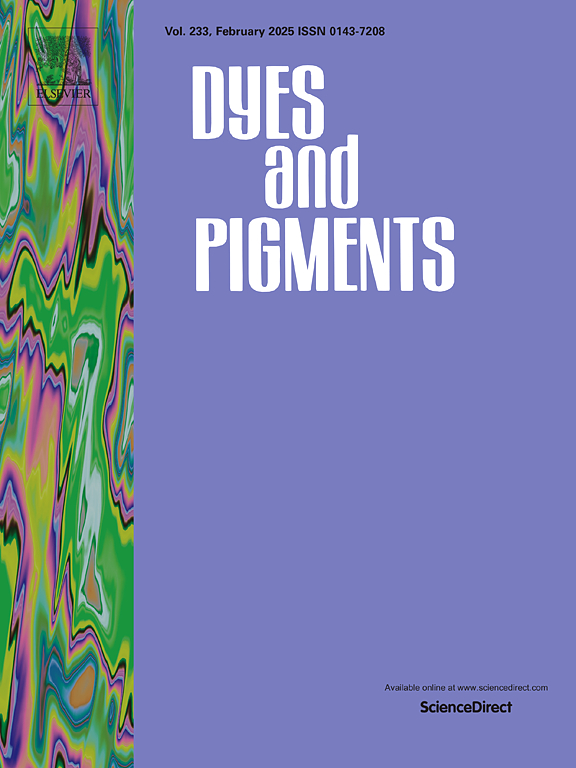High luminance and efficient non-doped blue OLED with negligible efficiency roll-off
IF 4.1
3区 工程技术
Q2 CHEMISTRY, APPLIED
引用次数: 0
Abstract
Efficient non-doped blue organic light-emitting diodes (OLEDs) exhibit admirable merits of simple device structure and low power consumption. However, efficient and stable blue devices are still rare. Herein, a novel blue molecule (PPyIAC) was designed by adding 9,10-diphenyl-9H-pyreno[4,5-d]imidazole (PPyI) to benzonitrile substituted anthracene. Single-crystal analysis displayed that it had formed highly ordered arrangement and abundant intra/intermolecular forces as well as weak π-π stacking in solid state, which not only accelerated and balanced the carrier transport, but also reduced excitons quenching caused by serious molecular aggregation, improving the stability of non-doped device. Furthermore, theoretical investigations have shown that the high-energy “hot exciton” channels avoided the accumulation of T1 excitons and reduced efficiency roll-off. Consequently, the non-doped device of PPyIAC exhibits a high luminance of 46778 cd m−2, and achieved a maximum external quantum efficiency (EQEmax) up to 9.2 % with a negligible efficiency roll-off (2 %) @ 10 000 cd m−2, resulting in superior performance in organic light-emitting diodes.
高亮度和高效率的无掺杂蓝色OLED,效率滚降可忽略不计
高效的无掺杂蓝色有机发光二极管(oled)具有器件结构简单、功耗低等优点。然而,高效和稳定的蓝色设备仍然很少。本文通过在苯腈取代蒽中加入9,10-二苯基- 9h -芘[4,5-d]咪唑(PPyI),设计了一种新的蓝色分子(PPyIAC)。单晶分析表明,它在固态下形成了高度有序的排列和丰富的分子内/分子间力以及弱的π-π堆积,不仅加速和平衡了载流子输运,而且减少了严重分子聚集引起的激子猝灭,提高了非掺杂器件的稳定性。此外,理论研究表明,高能“热激子”通道避免了T1激子的积累,降低了效率滚降。因此,未掺杂的PPyIAC器件显示出46778 cd m−2的高亮度,并且实现了高达9.2%的最大外量子效率(EQEmax),并且在10,000 cd m−2时效率滚降(2%)可以忽略不计,从而在有机发光二极管中具有优越的性能。
本文章由计算机程序翻译,如有差异,请以英文原文为准。
求助全文
约1分钟内获得全文
求助全文
来源期刊

Dyes and Pigments
工程技术-材料科学:纺织
CiteScore
8.20
自引率
13.30%
发文量
933
审稿时长
33 days
期刊介绍:
Dyes and Pigments covers the scientific and technical aspects of the chemistry and physics of dyes, pigments and their intermediates. Emphasis is placed on the properties of the colouring matters themselves rather than on their applications or the system in which they may be applied.
Thus the journal accepts research and review papers on the synthesis of dyes, pigments and intermediates, their physical or chemical properties, e.g. spectroscopic, surface, solution or solid state characteristics, the physical aspects of their preparation, e.g. precipitation, nucleation and growth, crystal formation, liquid crystalline characteristics, their photochemical, ecological or biological properties and the relationship between colour and chemical constitution. However, papers are considered which deal with the more fundamental aspects of colourant application and of the interactions of colourants with substrates or media.
The journal will interest a wide variety of workers in a range of disciplines whose work involves dyes, pigments and their intermediates, and provides a platform for investigators with common interests but diverse fields of activity such as cosmetics, reprographics, dye and pigment synthesis, medical research, polymers, etc.
 求助内容:
求助内容: 应助结果提醒方式:
应助结果提醒方式:


